The magic of desi games revived with a first-of-its-kind guidebook to help you make sense of Andhra’s nalugu rallu atta and our very own atya-patya. Sunday mid-day picks out four games to make the summer holidays in the outdoors an absolute treat
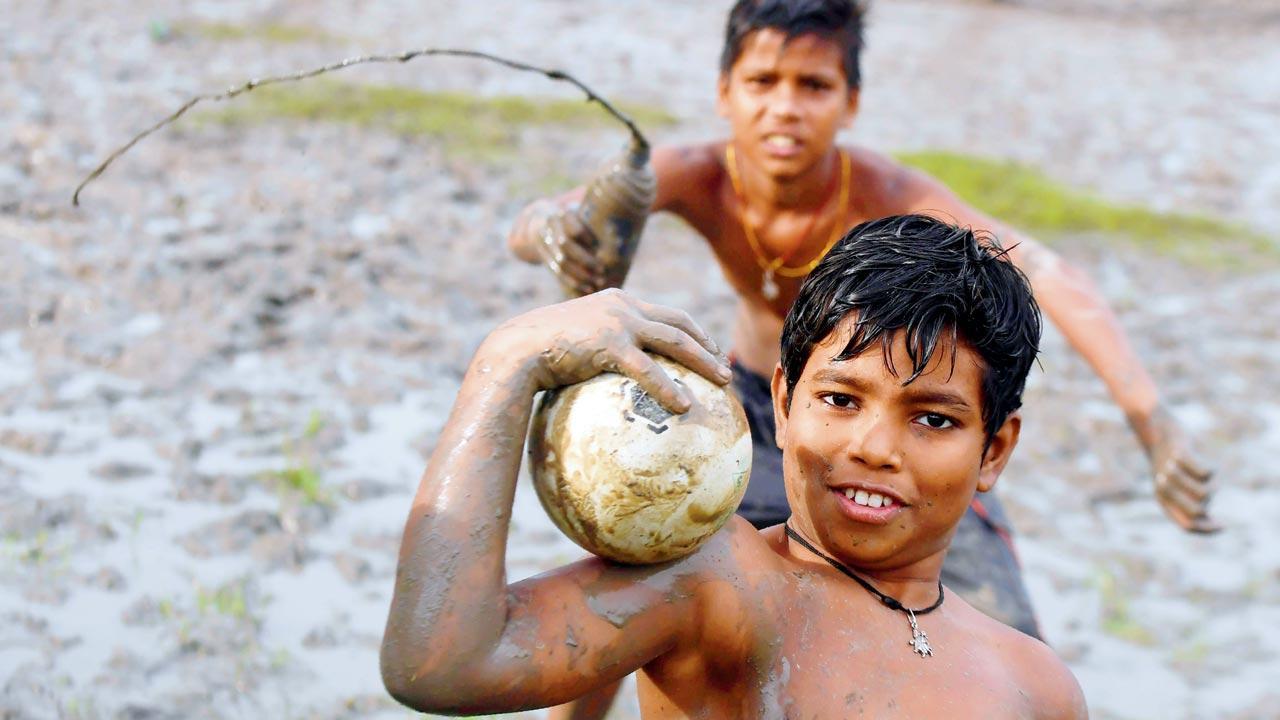
Boys play kabaddi in a water-logged ground in Kolkata. Co-author Sangeeta Goswami says that while researching, the duo learnt that kabaddi had nearly 70 variations. “We couldn’t wrap our heads around what [rules] to leave and what to include.” Pic/Getty Images
Sports enthusiast Amitabh Satyam spent his childhood on the field. Having grown up in a village in Sheohar, Bihar, he remembers playing innumerable games—all local favourites—sometimes on trees, or with lathis and stones. Mostly, Satyam and his friends loved a good chase, even if it was on one leg or moving stealthily like a gidad (jackal). Strategy was key.
Later, representing his college in gymnastics and athletics, and becoming absorbed with the more glamorous squash, golf, tennis and badminton, the games of his youth took precedence. “But these days, children barely play anything,” the Bengaluru resident tells us over a telephonic chat. Children, especially in cities, spend more time inside their homes, peering into their smart phones. “Sports adds tremendous value to life. It helps you deal with conflict and resource management, and problem solving... we wanted to bring back this culture that we are slowly losing,” he shares, of why he co-wrote the just released, The Games India Plays (Bloomsbury India) with his friend Sangeeta Goswami, who is a practising counselling psychologist and co-ordinator at experimental methodology school promoting integral education.
ADVERTISEMENT
 Sangeeta Goswami and Amitabh Satyam
Sangeeta Goswami and Amitabh Satyam
The book is a one-of-its-kind guide to playing games that originated in India, many of which disappeared into oblivion as competitive Western sports such as cricket and hockey took over the Indian imagination. Satyam and Goswami spent months researching over a hundred indigenous games played across the length and breadth of the country, narrowing it down to just 15, and included the lesser-known pacha kuthirai, nalugu rallu atta, gella chutt and vish amrut. They have also listed 14 other games with short descriptions for those curious about Indian games. Instructions ranging from the equipment needed, to the number of players, playing method, variations, detailed set of rules and how to keep score, make it a perfect handbook that children can carry around with them. “Western games require expensive equipment, but the games we chose [for the book] need little infrastructure or gear, and can be played anywhere,” says Satyam.
The duo says it’s unfortunate that with colonisation, the West institutionalised their educational and sports curricula in India and other parts of the world. “We cannot fight or challenge this past, but we need to find a way to bring it [these games] back into our mainstream,” he adds. “There’s also a need to change the mindset. If kids play any of these games [listed in our book], they wouldn’t even be considered sportspersons. Have you heard of a sportsperson who plays atya-patya [an ancient athletic sport played in Maharashtra and Tamil Nadu].”
Goswami says that indigenous games are no less than any other competitive sports played globally, especially when it comes to “strategising, technique, team building or intellect building”. “Atya-patya is a personal favourite—it’s a very physically, intense game with complex and well-formed rules.” The play involves running to the end of the field and back, cutting nine breadthwise sections while defending against the opposing team’s efforts to obstruct. “When one player reaches the final stage, s/he has to support the others to achieve the same level. Since I am an educator, I look at games differently—it also helps kids inculcate important life lessons.” Goswami says that while researching, the duo learnt that kabaddi had nearly 70 variations. “Every region and state has its own version of the game,” she says. “We couldn’t wrap our heads around what [rules] to leave and what to include. I think that was most
challenging for us. After going through each version, we had to extract the most crucial bits of the game, finally settling for the circle-style kabaddi.”
Satyam and Goswami put together the guide after speaking to several experts, researchers, and fellow sports enthusiasts from the regions where these were played. “What I like most about these games is that they can be played outdoors, they allow room for more variations, and involve each and every player in the team. Come to think of it, cricket is barely a team sport, because half of the team is always sitting and watching the game. A good game is when each person in the team is actively involved at all times, and is constantly engaged and strategising about what to do next, to ensure the progress of the game. No member is passive at any point in time,” he says.
Jod Saakli
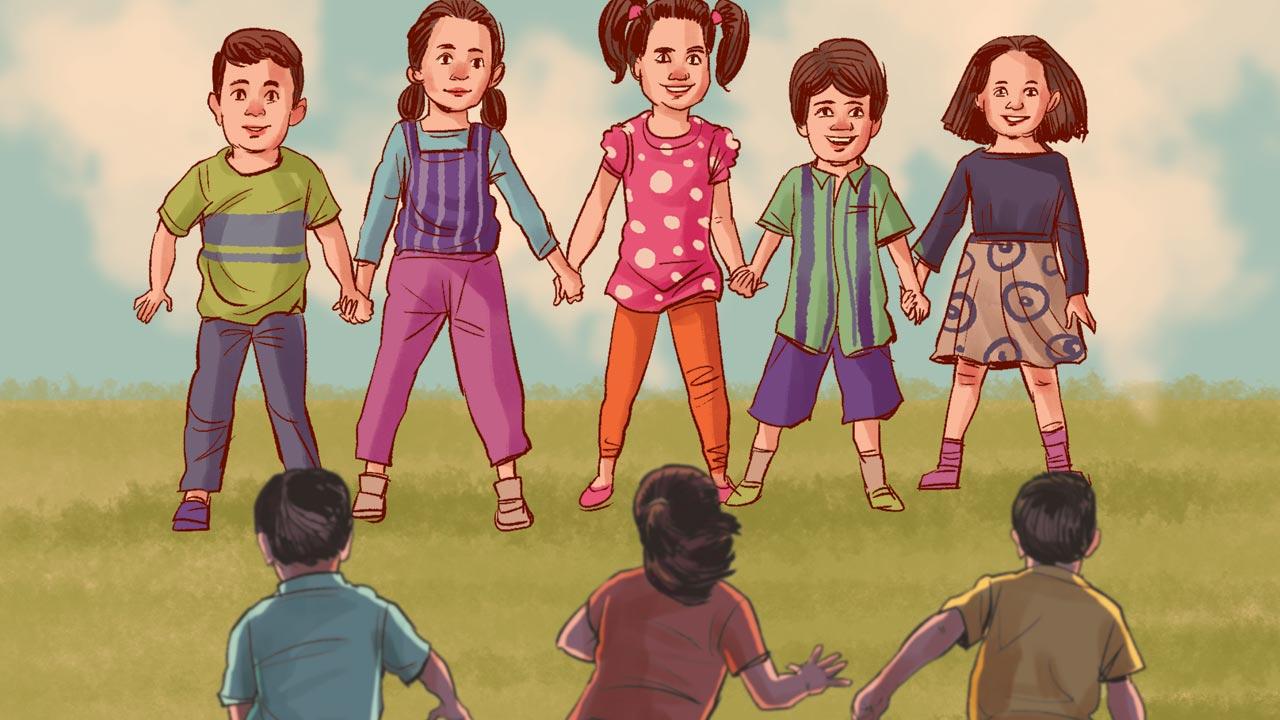 More players can join in at any stage during the game
More players can join in at any stage during the game
Number of players
The game [also known Son Sankali in Maharashtra] is enjoyable with six or more players. We suggest a maximum of 12 players. The beauty of this game is that more players can join in at any stage during the game.
Playground
This game is an outdoor game that involves running and chasing. So any open ground with an even surface and without potholes—grass fields, school compounds, streets, parks—will be suitable for playing. Mark a boundary according to the number of players. An area measuring 60 ft x 60 ft will suffice for 10 players.
Playing method
Start the game by selecting a chaser. Other players in the group will be the runners.
1. All the players spread out in the playfield. On the captain’s signal, the chaser starts to chase the other players and catches anyone possible.
2. After the first runner is caught, the player joins the first chaser as an integral member of the chasing team.
3. Both chasers now hold each other’s hands and run together to catch the next runner.
4. As the chasers catch more runners, these runners join the chasing team. They join hands to form a chain and chase the remaining runners together. As both the hands of the chasers are locked in the chain except for those at the end, only the two chasers at the end can tag a runner with their free hand.
5. Eventually, the chain of chasers becomes longer, and the game continues until all other players are linked in the chain except the last one.
6. Players can choose to play more innings, and the points gained by the players in the second innings will be added to the points from the first innings. As they play more innings, the points will get added.
7. The player with the maximum points at the end of the game is declared the winner.
8. Runners are allowed to move around the playing area and have to stay away from the chain chasers.
Scoring
The score gained is based on the order in which a runner is caught. The first person to get caught gets the least points, and the points increase in the order of getting caught. The first runner to get caught gets one point, the second two points and so on. The last player gets the maximum points. If there are nine players, then the last player standing gets eight points and is declared the winner for the innings.
Rules
1. The hands of all the chasers must be locked in the chain at all times. The players in the middle can’t unlock their hands and tag runners independently.
2. If the chain is broken at the time of tagging a runner, then this tag is not valid.
3. The runners who move out of the boundary are automatically ruled out of the group and join the chain of chasers to catch the remaining players.
4. The chain must not be broken, and it goes on increasing in length as more players join.
5. The player who is caught first will be the chaser of the next game.
Yubi Lakpi
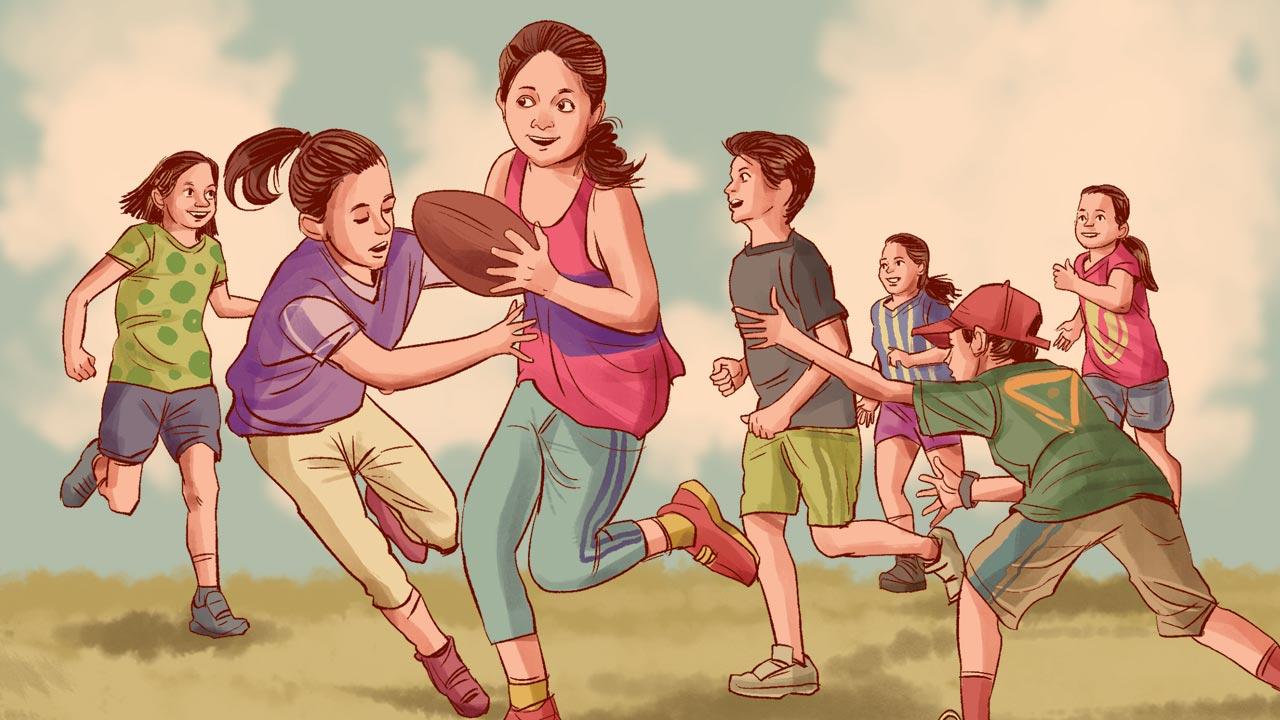
Number of players
As the game is about an individual’s performance, there is no limit to the number of players. We recommend no more than seven players and no less than four.
The playground
The sport, known as Manipuri rugby, is played on a rectangular field, about 45 m x 18 m in dimensions. Going lengthwise, one end of the field has a 4.5 m x 3 m box area after the finish line, known as the goal region. The goal region is mostly indicated by a pole or two pieces of white cloth rolled up to look like a flag. There is only one goalpost.
Playing method
1. The players assemble behind the start line outside the boundary of the playground.
2. The game starts with the referee placing the coconut inside the playground, near the start line. Immediately after that, the referee signals the start of the game with a whistle. The players rush inside the playground, and each one attempts to grab the coconut.
3. The player who grabs the coconut holds it to the chest and runs towards the goal, manoeuvring to avoid getting caught by the opponents.
4. As soon as the player with the coconut starts running, the others rush to push him or her to the ground. Once down, the player tries to get up, but the others storm over to push the player down, each trying to snatch the coconut. But the player with the coconut makes every effort to hold on to it. It requires a great deal of energy, fitness and stamina to endure extensive strain.
5. When another player snatches the coconut, that player now rushes towards the finish line. The process of rushing and catching begins all over again with the new player as the target. Then the coconut is snatched by yet another player, and the game continues.
6. With each new player getting the coconut, the group reaches closer to the goalpost. While the game may appear simple, it is difficult to get a noticeable breakthrough and reach the goalpost, considering each player is slippery and hard to hold. After several tussles, one of the players gets to the goalpost.
7. At this final stage, an intense struggle occurs when one of the players slips away with the coconut after defending against all the players. Such escapes require agility and strength.
8. Once a goal is achieved, the game is over.
9. The winner offers the coconut to the chief or the judges sitting just beyond the goal line.
10. The next round of the game can start, and will keep going for pre-defined time, say 30 minutes or till the players agree to play.
Scoring
No scoring points or team structure is applied in this game. The player who reaches the goal box first with the coconut is the sole winner.
Rules
1. Players must hold the coconut against their chest or carry it under their arm. It must touch the body at all times.
2. Players cannot kick, punch or beat the opponents or tackle players who do not have the coconut.
3. Players cannot kick the coconut. The coconut must be carried with the players all the way to the goal.
4. Players are allowed to tackle only the player carrying the coconut. They cannot hinder or obstruct other runners.
5. The player who reaches the goal box while in possession of the coconut is the winner.
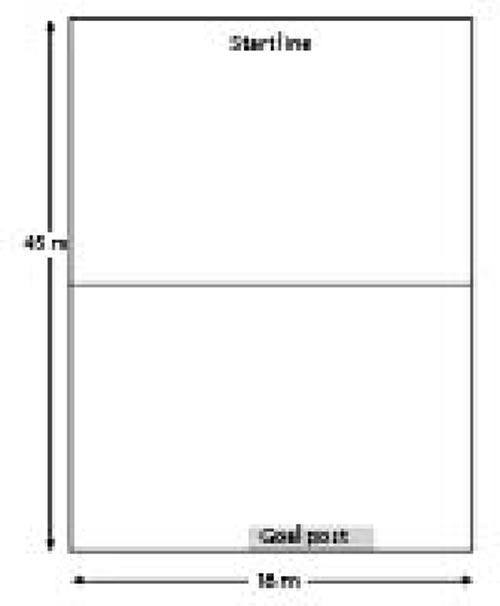
The sport is played on a rectangular field, about 45 m x 18 m in dimensions, with only one goalpost. Illustrations/Uday Mohite
Nalugu Rallu Atta
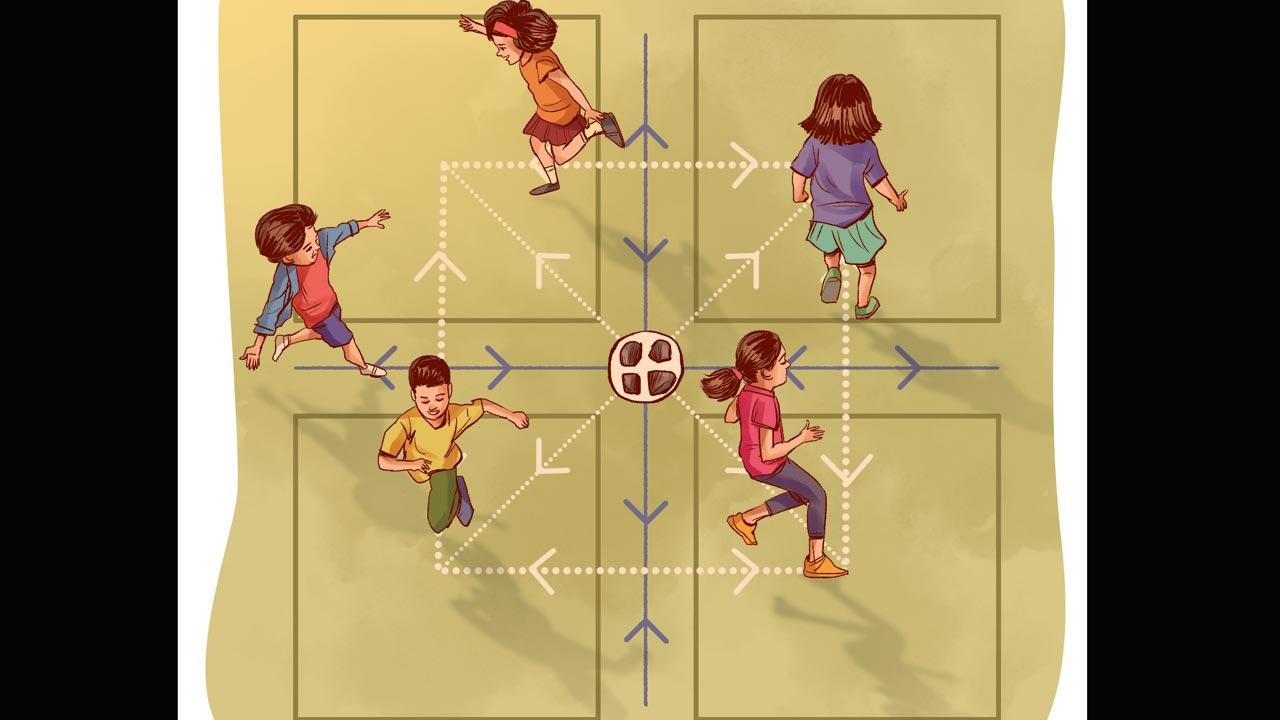
Number of players
This game originates in Andhra Pradesh. There are five players. Of them, one will be selected to be the patwar. So there are four runners and one patwar.
The playground
Four independent square boxes of sides measuring 5ft are drawn, leaving tracks of about 2ft between them, on an open flat playground measuring around 12ft x 12ft At the intersection of the paths between the squares, a circle is drawn with a 6 in diameter. Four medium-sized stones are placed in that circle.
Playing method
1. The players’ names are written on pieces of paper, and the player whose name is picked becomes the patwar. This way, the patwar is randomly chosen at the start of the game. Players can choose any other method as well in an informal game.
2. The other four players stand in the four boxes (one in each), which they occupy as their native houses.
3. The play begins when the patwar starts cutting the four tracks one by one—touching the end lines and returning to the centre quickly. In doing so, the patwar has to leave the centre and go till the end of the court four times, moving in the tracks only in the space between the square houses. Meanwhile, the runners try to take one or more or even all four stones placed at the centre without being caught by the patwar.
4. After cutting the tracks, the patwar keeps moving along the cross-section to capture the runners who try to steal the stones. The patwar is not supposed to enter the boxes.
5. One of the players can also pick up all four stones and then move into other boxes, distributing the stones to the remaining three runners. Only one player need not necessarily take the initiative to collect all the stones. Any runner can pick up as
many stones as they can for distribution.
6. When each runner has at least one stone each, there is no need for distribution.
7. When all the runners get their stone, running and chasing stops. Runners ask the patwar to choose either gumpu (group) or chhuttu (separate).
a. If the patwar says gumpu and selects a particular box, then all other players gather in that box with the stones in their hands. The patwar can tag any runner anytime when they move close enough.
b. If the choice is chhuttu, each runner has to make three rounds starting from the present box and finally reach his or her native box while escaping the patwar’s touch. The patwar can tag any runner while they are moving across the boxes to settle in their respective boxes.
8. In both the gumpu and chhuttu options, if the patwar catches any of the four runners, he or she will be the new patwar of the next game.
9. The game continues for the next two innings with all five players, and the winner is declared after all the three innings are played.
Scoring
One set of the game consists of three innings with the same five players. The winner is the runner who is not caught during all innings of the game and escapes being the patwar every time.
Rules
1. One box can be occupied by only one player as a house (native square).
2. The patwar can move only along the cross sections between the squares, horizontally or vertically, but cannot enter any squares or go out of the boundary.
3. The other players can move in all directions, through the squares and in cross sections within the boundary.
4. When the patwar’s choice is gumpu for the second round, all the players will gather in one box if and only if they have acquired their stone—one
stone each.
5. The game continues until all the four players gather in one square with all the four stones. In chhuttu, all players must reach their native squares after running three rounds, passing through all four squares and
escaping the tag by the patwar.
6. If a player is tagged out as per the rules, then he or she becomes the new patwar, and the former patwar will join the other runners. The game then starts again with the same rules.
7. If the patwar catches one of the runners while they are moving through four boxes, the runner is declared out and becomes the next patwar in the new game.
8. If the runners successfully grab all four stones and pass both rounds, they get the chance to be runners again. The same patwar will be the chaser in the next game.
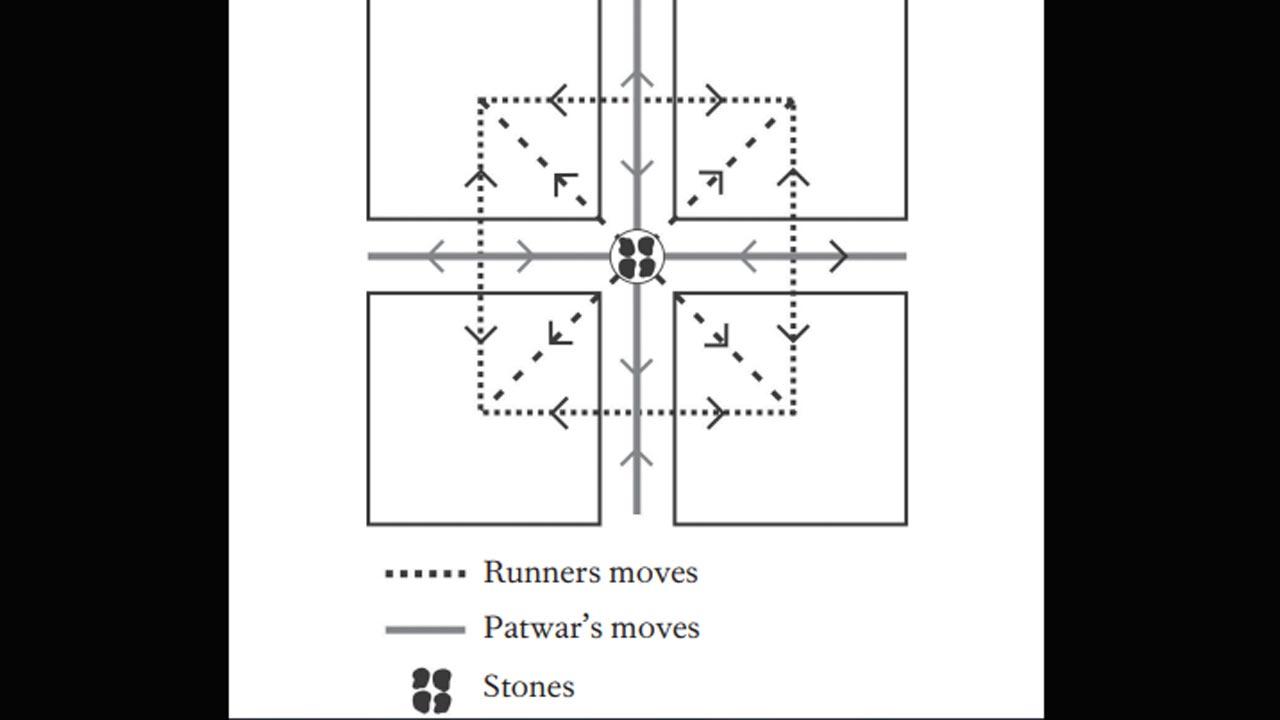
Lagori
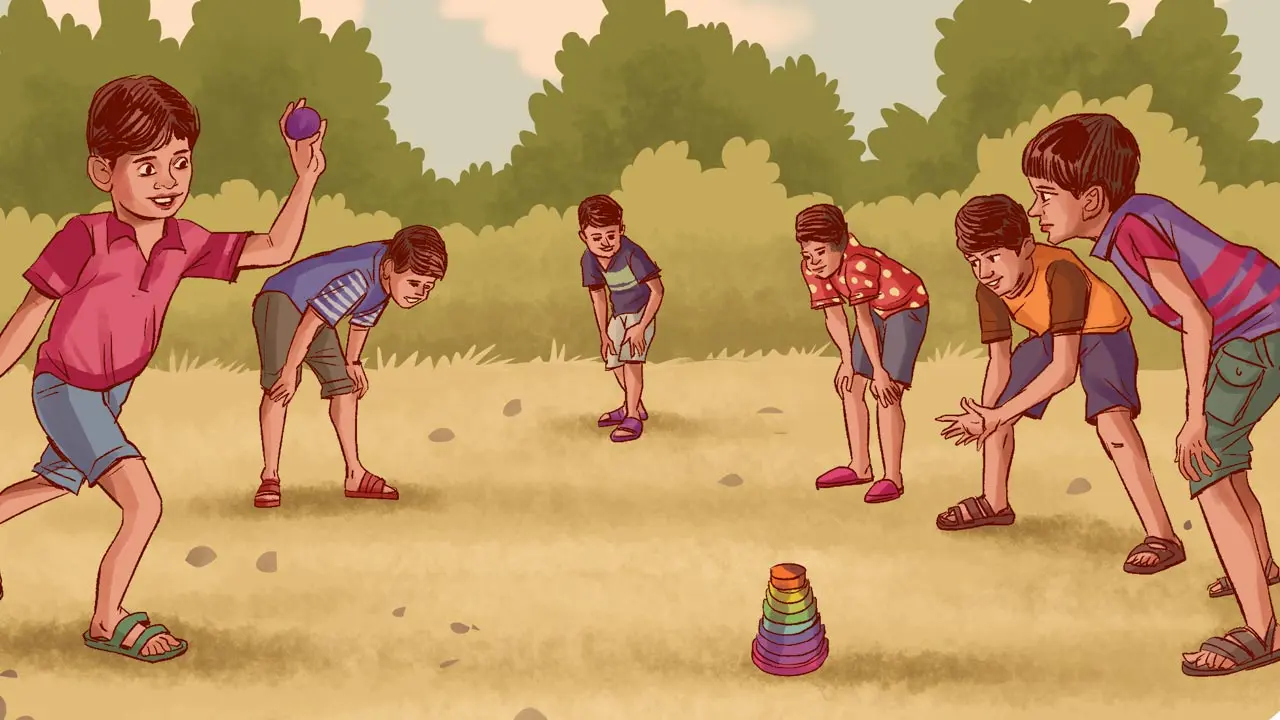
Number of players
Originating in southern India, the game is now popular all over the country. There are two teams with six players each in formal tournaments. The game can also be played with only two players on each side.
The playground
Lagori playgrounds can be set on grass fields, sand, concrete or any open area in an informal setting.
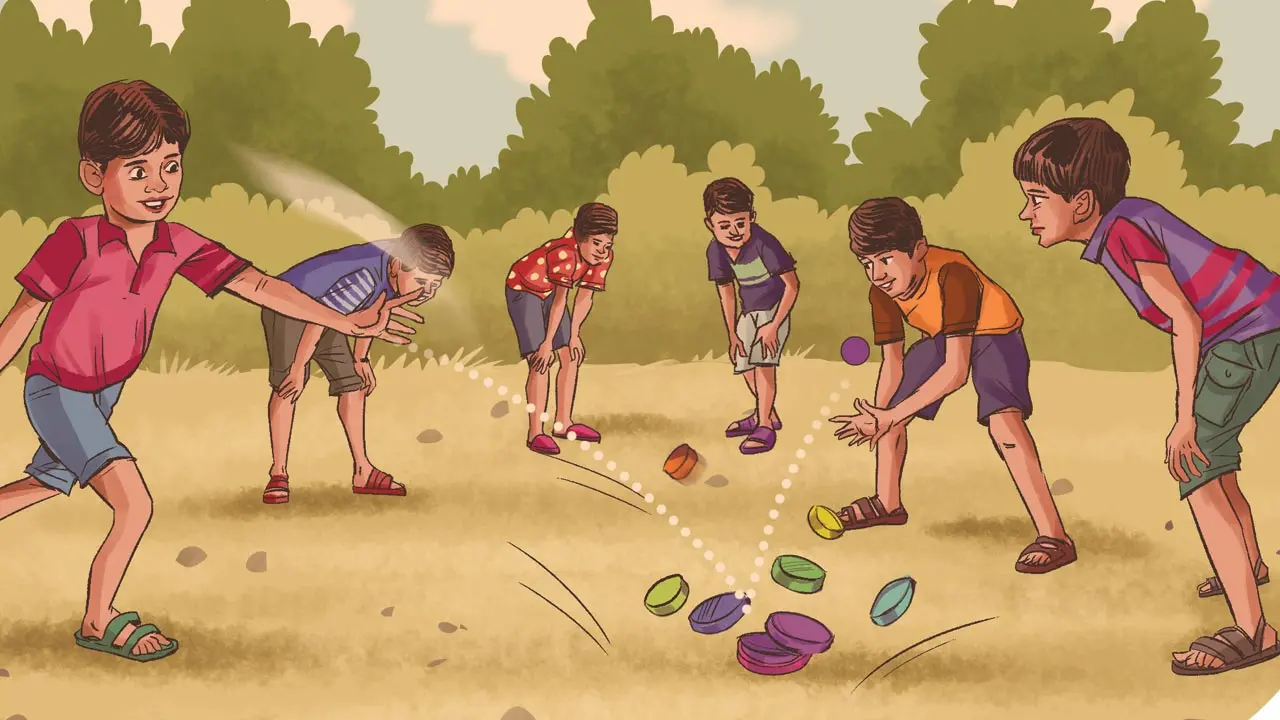
Playing method
Set boundaries for the playing field. Draw a circle in the centre in which the seven stones are stacked on top of one another, with the smallest on the top to make a lagori (stack).
1. The striker team is called breakers, and the fielding team is known as defenders. A coin is tossed to choose which team will play the breakers’ role first.
2. After the selection, the stones are stacked to form the lagori. Any of the defenders can do this. The discs are stacked to provide maximum stability and
resistance to soft hits by a ball.
3. One of the defenders takes a position behind the stack at a distance of about 4ft to catch the ball thrown by the striker. To catch the ball from any direction, other players will take positions by scattering around the lagori.
4. All the breakers will take their position behind the crease line in the breakers’ part of the field.
5. One of the breakers, generally the one considered the best at aiming, starts the game by attempting to strike the lagori with a ball-throw from the crease line.
6. If the lagori is not disrupted and any defender catches the ball after the first bounce, then the striker will be declared out, and the next player of the breakers comes on the strike.
7. If the lagori is not disrupted and the defenders do not catch the ball, then the striker will get two more chances to knock over the stack. After three failed trials, that striker’s turn is over, and the next player from the breakers will play.
8. The breakers get nine chances in total—three chances each for three players—to break
the lagori.
9. After the lagori is broken, the defending players catch the ball and aim at the breakers to hit them below their knees or on their back.
10. At the same time, the breakers gather near the lagori and try to quickly restack the discs. They must stay alert to scatter rapidly because the defenders keep throwing the ball at them. The striker and rebuilders co-ordinate while dodging the ball thrown at them. This task is not easy because a member of the defending team stands near the lagori, waiting to get the ball from a teammate.
11. After restacking the lagori, the breakers trace a circle around it three times with their fingers and then shout ‘lagori’. Thus, they get one point and also the chance to hit the
stack again.
12. However, if the defenders succeed in hitting any breaker before they rebuild and shout lagori, then the breaker team is out. The ball will then go to the defenders, and in the next game, they will be the breakers.
13. When the defenders get the ball to hit the breakers, they must not run with the ball. Instead, the player with the ball must throw it either directly at the breakers or to a teammate who has better chances of aiming at the breakers.
14. When the ball changes hands, the defenders play as the breakers.
Scoring
1. If breakers can rearrange the discs before getting tagged out, they get one point and the next turn to play as breakers.
2. If the defenders hit any of the breakers before restacking thelagori, the breakers would be out. The defenders get to
play as breakers next. Defenders do not score any points for this.
3. The team that scores seven points first will be the winner.
Rules
1. If a striker cannot knock down the stack, then he or she is given two more chances—a total of three strikes. After three failed strikes, the ball goes to
another team member.
2. If the breakers cannot knock down the lagori in nine tries, then the defenders get one point and will now get a turn to be the breakers.
3. In any of the three tries, if the striker’s ball does not disrupt the stack and is caught by an opponent after one bounce (a tip) behind the lagori, then the striker is out.
4. Players from the defending team cannot run with a ball in their hand. The ball should not remain in the player’s hands for more than three seconds. They have to keep passing the ball to their teammates who can tag breakers conveniently.
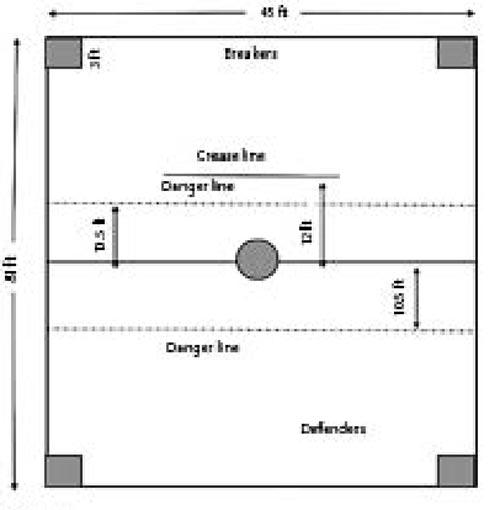
For formal tournaments, the playground has to be 81 ft in length, and 45 ft in breadth. Pic courtesy/Bloomsbury India
Excerpted from The Games India Plays by Amitabh Satyam and Sangeeta Goswami, Bloomsbury India
 Subscribe today by clicking the link and stay updated with the latest news!" Click here!
Subscribe today by clicking the link and stay updated with the latest news!" Click here!








